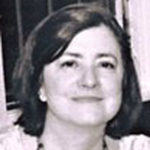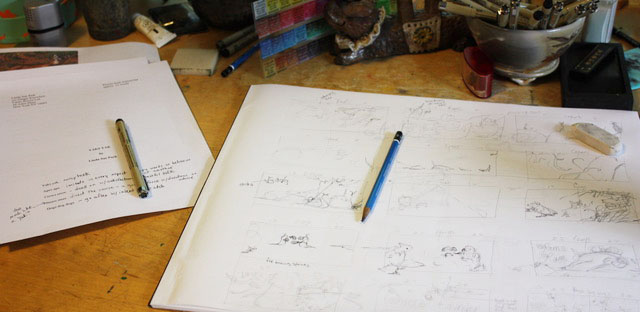Here on Picture Book Builders we love to chat about how beautiful books are created. It’s my opinion that one of the under recognized contributors of the ‘team’ is the art director. I have been fortunate enough to work with Senior Art Director/Creative Director, Christine Kettner on three books. She was gracious enough to stop by Picture Book Builders and give us some back story regarding the creative process of making a book~ Welcome, Christine!

What is your background and when did you know you wanted to be an art director?
As a child, I always drew and painted. But I liked getting out of the house and wanted a steady income. It made sense to me then to get a job that provided financial security and got me out into the world but was creative. I also fell in love with typography in college. All these factored into becoming a designer and art director. Both are equal in making a great book package.
You not only design the physical look of the book, but work as the liaison between the editor and illustrator. And— you do all that while overseeing the technical production of the bookmaking. Can you take us through the basic journey and tell us the steps that happen after the manuscript has been acquired by the editor and the text is ready to be turned over to an illustrator?
Each artist I work with has a different process. Some like to be just given the raw manuscript and run with it. Others want the manuscript broken up into a layout and have direction provided. Either process works fine. It is the end result that counts. At this early stage, the text font type has not been decided.
The first sketches are provided. The art director discusses with the editor and comments are given to the artist. We look for consistency in the characters/settings. We also look at the characters. Do we like the way the artist is envisioning the character. Is the character the right age? Wearing the right clothing? We look for other options for the artist to better illustrate the copy. Sometimes we move the art/text to either a previous or next page for pacing and better story telling of the manuscript. The first set of sketches is really important and we try catch all that we can. The artist after receiving the comments, often will come up with something we have haven’t thought of. Through this process of collaboration, we are making a better book.
We then get a second set of sketches from the artist and go through the same process. At this point, we are getting closer and so there are less revisions. We can ask for a third or fourth set of revisions. But usually at that point, it is only for a few pages or spreads. This process continues until we are satisfied with the sketches.
At this point or earlier, I ask the artist for some final art pieces so we can decide on the text type. I like to do several options of text type options. The text type for a picture book needs to be easy to read for the age group, but also works well with the art. The text type can either compliment or work against the art. It amazes me how the text type can really change the look of the book. Each font has a mood I think. And you need to choose the weight, size and the lead (space between the lines) carefully.
Once we have chosen the text font, a mechanical layout is run out with sketches in place. This then goes through copy editing. The artist is now executing the final art. And sometimes will send us low res pieces as they go along. We can comment or catch anything at this point as well. Can you beef up the color? is one example of a comment we might make. ‘This piece of clothing color needs to be consistent’ is another.
Once the artist delivers all the final art, we lay out the art and look at it as a whole, again trying to catch anything Many ooohs and aahhs are usually said at this stage. We are always excited to see all the art in. Many artists work digitally now. And if so, we can make printouts. The art is then sent out to our production department for scanning if the artist delivered actual or we call it reflective art.
Once the scans are in, the designer/art director replaces the sketches in the layout mechanical. Sometimes even at this stage, we have to go back to the artist for corrections. But generally they are minor. The book is soon sent out for press proofs for color correcting. Press proof are sent to the artist for comments. Sometimes if the artist is in town, they come in for color correcting.
All the hard team work is paying off to create a beautiful book.

(This is a picture of my board with the manuscript and thumbnails for Yaks Yak, by Linda Sue Park which I worked on with Christine.)
A good art director sees the potential in an illustrator just like an editor can read a story, know it has a ways to go, but knows it will get there and that the writer will be able to accomplish that task. You get tons and tons of postcards and submissions, what is it that convinces you that an illustrator will really be able revise, collaborate, and execute a whole pb? Isn’t that hard to tell?
It is hard to tell. If an artist has done other books that makes the job easy of deciding. But if it is an artist just out of school or an artist that has not done a book before it is difficult to see. What helps is if the artist has in their portfolio a complete or partial book dummy with several final pieces of art. This shows the artist can tell a story through their art, handle composition and pacing and keep a character consistent. There also has to be something about the artist style that catches the art director’s eye.
How do you select an artist for a certain project? This is going to determine the whole visual and read of the picture book. Can you give some examples where you married certain styles to manuscripts?
I don’t know if I ever saw a particular style for a certain picture book manuscript. That is more true for a cover for a YA novel or a middle grade novel where trends for packaging the book is important for marketing the book. Sometimes for example photographic treatment is more in style than illustration for example. That changes constantly, by the way.
I would say there could be many different styles that could work for a picture book manuscript. For me, it is a very gut feeling sort of thing. And can’t really be described. It’s sort of I know it when I see it.
One point that often surprises people is that when an illustrator is offered a manuscript the author is pretty much kept out of the picture. Is what I said a correct statement of the process?
Sometimes the author is involved early on and sometimes they are not. Sometimes the author has some thoughts about the manuscript that they share for us to pass along to the artist. If the author is not involved and has big objections however, of course we would listen!
What is it about picture books that you enjoy being a part of and why?
I love working with art and typography. And creating a product that a child holds in their hands to read or even learn how to read and and expands their world is an amazing contribution I can make in my life. I also love working with editors, artists, production managers, copy editors, proof readers that are equally excited about the process. People in children’s books are in general an amazing group!
What are some of your favorite picture books from your childhood— or just all time— and why?
I loved HARRIET THE SPY. I still have my original paper back copy. For those of you who don’t know the story, she makes intelligent (and sometimes mean) observations about the people around her in a notebook. After the notebook is discovered by her classmates, she is ostracized. She also loses her beloved childhood nanny. But after this difficult period of loss, she survives. Childhood can sometimes be lonely and books like HARRIET THE SPY can get you through. I also loved CHARLIE AND THE CHOCOLATE FACTORY. I think I read it in one sitting.
And, finally, what are some of the books that you have designed/worked on that you love the most?
I don’t like to say. It is like saying which is your favorite child. I have been fortunate to have a long career and I have worked on many great books!
Thank you, Christine! I’ve learned a lot and am certain our readers have as well!
Thank you!
http://buywithoutprescriptionrxonline.com/propecia.html
http://rxnoprescriptionrxbuyonline.com
http://noprescriptionrxbuyonline.com/nolvadex.html

This was so interesting. Thanks for the great interview, Jennifer and Christine!
Hi Katrina! Thank you so much for visiting Picture Book Builders today and taking the time to comment! I’m glad that you enjoyed the interview!
This has been so educational to read, Jennifer. Thank you for choosing to spotlight all the work of an art director.
I’m so glad you enjoyed the post, Traci! Thanks for visiting today!
Picture books are truly a collaborative art. Thank you for sharing!
Laura, they really are and I absolutely love getting to be part of a creative and collaborative process. I’m glad you stopped by today and took the time to comment, thank you!
Very interesting interview. I enjoyed learning what an art director does and the process of coordinating all the artistic details involved in picture book production.
Hi Judy, thanks so much for visiting today! I’m so happy that you enjoyed the interview!
Great interview! I loved reading how the art director, illustrator, and author work together. You make it sound so simple, but in fact, I know it is a long process with hours and hours of work (or days and weeks and months!). Thanks!
Thank you, Angie, for taking the time to read and comment. Isn’t it uplifting that making books for kids is such a creative collaboration? Have a wonderful day!
This was so interesting! I like to pore over text type and font choices as well. I find even changes in text color can convey a great deal in terms of mood and pace. I must remember to think about potential text options in my manuscripts!
Hi Cathy, I’m glad you enjoyed Christine’s interview. Thank you so much for visiting today!
I love knowing the ins and outs of picture books and how everyone at the publishing house works as a team. Thank you for the interview!
Thanks, Kathy! It really is a collaboration. Thanks so much for commenting!
Difficult for us non-illustrators to imagine all that goes into picture book creation. THANKS, Jennifer and Christine, for this fascinating post!
Thanks, Jill!
Fun to read how it all comes together. Thanks for sharing!
Thanks, Tina!
What a fabulous interview! For me, there’s always a little bit of mystery around what happens between the illustrator and art director, so I loved hearing Christine’s perspective. Thanks to you both!
Thanks for sharing this! I loved getting a “peek behind the curtain.”
Anyone who thinks picture books are just cute little books needs to read interviews like this one and learn about all the teamwork and dedication that goes into producing one. Great interview, Christine and Jennifer.